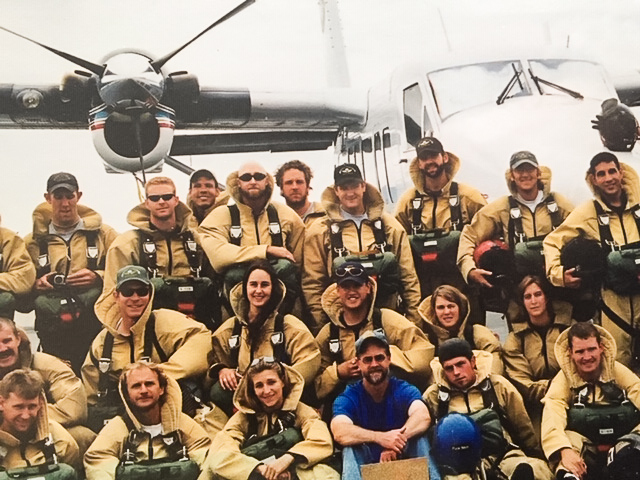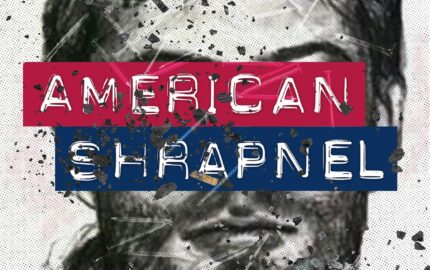A journalist can ask their subject hundreds of questions and get a great chunk of the story. But it’s when the reporter listens in on an unprompted conversation — whether it’s with a friend or a stranger, small talk or a heavy heart-to-heart — that’s when the subject can reveal themselves in new ways unknown to the reporter.
People engage in dialogue with one another every day. Dialogue is in the books we pick off our shelves that reveal a character’s personality and flaws. The same can be said for countless narrative works, and are extremely effective when getting to know the subject.
From the Nieman Storyboard annotation archives, here are five pieces that use dialogue in a variety of ways, and what its authors say about it:
1. Catching a natural conversation at the scene: Jeanne Marie Laskas and ‘Guns ’R Us’ (2015)
Jeanne Marie Laskas, a correspondent for GQ, was thinking about the shooting in Tucson, Ariz., that critically injured U.S. Rep. Gabby Giffords and killed six others, and she wondered who decides to sell or not to sell guns to certain people. Her editor encouraged her to get behind the counter of a gun store.
Laskas did just that, starting with simple exchanges between clerk and customer, then leading into the bigger issue of gun violence in America.
Laskas starts out with this dialogue between two young men and a woman with a sparkly purse, looking at AK-47s in an Arizona gun shop:
"You have to admit this is pretty badass," the one man was saying. He had a carbine shorty perched on his hip, Stallone-style.
"I don't know," the woman said. "To me, it looks mean."
"It's supposed to look mean."
"They should make it in pink," she said. "Wouldn't that be cute?"
"You're shitting me."
"They should make it in Hello Kitty!" she said. "I would totally buy it if it was Hello Kitty."
"Sweet holy crap," the other man said. "That would be the worst possible death. Can you imagine? Shot dead by a Hello Kitty semiauto."
Here’s why Laskas wanted to start with this conversation:
It is just a glimpse of a moment. I’m writing about a shopping experience, and here is a glimpse of the shopper. Probably 15 of them happened, but here is a funny one. The idea would be to provide a quick moment. It’s not loaded, to use a pun here, but I don’t have a point. This is not a polemic. Almost trying to show that.
2. A ‘fly on the wall’ approach: Susan Orlean and the American man, age 10 (2014)
Susan Orlean believed that profiling the average person was more interesting than profiling a celebrity. Taking that thought, the New Yorker staff writer set out to follow a not-at-all famous 10-year-old boy for Esquire.
She followed Colin Duffy at school, at play dates, and at family dinners, again and again and again. The experiences Orlean had with him and the commentary she gives in the story give the reader a thorough glimpse into the life and mindset of a young boy.
A perfect example is this moment between Colin and his best friend Japeth:
The girls in Colin's class at school are named Cortnerd, Terror, Spacey, Lizard, Maggot, and Diarrhea. "They do have other names, but that's what we call them," Colin told me. "The girls aren't very popular."
"They are about as popular as a piece of dirt," Japeth said. "Or, you know that couch in the classroom? That couch is more popular than any girl. A thousand times more." They talked for a minute about one of the girls in their class, a tall blonde with cheerleader genetic material, who they allowed was not quite as gross as some of the other girls. Japeth said that a chubby, awkward boy in their class was boasting that this girl liked him. "No way," Colin said. "She would never like him. I mean, not that he's so ... I don't know. I don't hate him because he's fat, anyway. I hate him because he's nasty."
"Well, she doesn't like him," Japeth said. "She's been really mean to me lately, so I'm pretty sure she likes me."
"Girls are different," Colin said. He hopped up and down on the balls of his feet, wrinkling his nose. "Girls are stupid and weird."
"I have a lot of girlfriends, about six or so," Japeth said, turning contemplative. "I don't exactly remember their names, though."
Orlean said she does not tend to record conversations, so here’s how she got it:
I scribbled madly. They chattered to each other enough that I could catch up with my notes while they tracked off onto something less interesting. I definitely paid the price for not using a tape recorder, but I was with them for so much time that the tapes would have been ridiculously long, and I would argue that a tape recorder would have made them more self-conscious. Somehow, a pad and pen just doesn't intrude the way an electronic gizmo does. I also know I listen more attentively when I'm the one and only recording device, and at the end of the day, that's the single most important thing I can do. If I'm not really engaged and paying attention, it's not going to work. If I don't get every line of dialogue, I'll manage with what I have. If I haven't really paid attention, I can't write a good piece.
3. The use of both external and internal dialogue: How film class led to fighting wildfires which led to finding a home which led to a memoir (2015)
Sarah Berns went to study film at Wesleyan University, but when she wanted to make her senior thesis film, she had to get money fast. Always enamored with the West, she went to Washington state to be a smokejumper, a firefighter who parachutes from planes onto remote fires.
She ended up writing about her experience for Outside magazine in her piece “Finding Home in the West — by Smokejumping,” largely centered on how she fought to prove herself as an equal in a field dominated by men.
Here is a piece of dialogue that’s external as well as internal, detailing how her axe cut her leg after fighting a fire in Oregon:
I looked down at my now-red leather boot and wondered: retardant or blood? I yanked the ax from my leather boot and felt an enormous volume of liquid rushing out: definitely blood.
I hobbled off the fire and hiked to the nearest road (which wasn’t near) to catch a ride into the town of John Day and argue with a nurse.
“No, you cannot cut off my boot.”
I explained that it would take weeks to break in another boot. But what I was really thinking was: I’m not going to let this accident take me out of my own competition.
The nurse and I had reached a stalemate when the rappel base manager arrived. I was mortified to see him. I am not that weak, clumsy girl. Not me, not today. I turned to him.
“Will you pull off my boot?”
Berns explains why she chose to include internal dialogue, a device she uses throughout the piece:
I am constantly rehashing events and conversation in my own head, so writing this way feels totally natural to me. The internal dialogue is my true voice – it’s the way I talk, negotiate and process with myself. My inner voice is often at odds with what I’m doing physically or saying aloud. This is the way I navigate the world.
4. Using dialogue as a literary tool: Navigating ethics, culture and safety to immerse in immigration and Covid (2020)
Immigration reporter Hannah Dreier has reported on violence in many countries in the past. But her coverage of a woman from Colombia living in a shared home in New Jersey while her tourist visa expired was “by far the most anxious reporting experience I’ve ever had.”
For The Washington Post, Dreier went to New Jersey to meet Tatiana Angulo and cover her story in the 24 hours before her visa expired — during the first month of the COVID-19 pandemic.
Dreier documents a conversation between Angulo and her friend Yesenia Sarria while they collected white rocks on the waterfront and confided in each other:
Tatiana wondered aloud if she would have been better off returning to Colombia, where at least she could visit her children, prompting Yesenia to reassure her that she was doing the right thing by staying. Yesenia reminded her how amazed she’d been when Tatiana managed to get a visa.
“That’s not an easy thing, to get to the U.S.,” Yesenia said. “You have to try, because you’ve been given everything. Everyone in Colombia wants the American Dream.”
They looked up and down the empty beach. Tatiana remembered how scared she had been when she first came.
“People always said there was lots of drug addiction here,” she said.
“And crazy people, like in the movies,” Yesenia said.
“But then you get here and it’s just normal. Beautiful,” Tatiana said.
Dreier said this when asked about her dialogue choices:
I liked that the friend was talking about the American Dream, because it would have felt too cheesy to insert that phrase into the story in my own words, but felt OK coming up organically in this conversation between two immigrants. [Post editor David] Finkel once told me that the most affecting parts of quotations are often the throwaway words people put at the beginning and end of sentences, so I was listening for that, too. Like the “beautiful” at the end of this one.
5. Including the reporter in the dialogue: Embedded war reporting with courage and common sense (2023)
Luke Mogelson has covered wars in Iraq, Syria, Afghanistan and, more recently, Ukraine. He has reported on the war from infantry units and combat zones, and stressed how important it is for him to see the war firsthand and through the lens of its most critical players.
In his story for the The New Yorker, he chronicled the war through the eyes of a team of soldiers.
Mogelson introduces one of the main characters, 37-year-old “Doc” from the United States, in a scene where they were at an outdoor restaurant in Kyiv. He includes this brief moment:
Toward the end of our meal, an older man in a leather fedora approached our table. “International Legion?” he asked, in accented English. I pointed at Doc; the man extended his hand and told him, “I just wanted to say thank you.”
Doc scrutinized his glass, embarrassed. After the man left, I remarked that such recognition must feel good. “It feels weird,” Doc replied.
Mogelson inserted himself in this exchange, and here’s why he thought it was necessary:
It’s much better if characters talk with one another than if they talk to the journalist. Of course, that’s not always possible, and in this case, because we were alone, I had to nudge Doc to get him to articulate what he was feeling. So, yes, I said, “That must feel good.” By not quoting myself, I hoped to emphasize Doc’s words rather than mine. For whatever reason, putting words in quotes makes the person who spoke them a more specific identity, and I don’t want to be that in the text — I want to be a cipher or a foil.
***
Emilia Wisniewski is a general assignment reporter and engagement editor at the Concord Monitor in New Hampshire. She previously worked at Boston.com and The Boston Globe as a correspondent where she covered local politics, business, health, and environment.
Subscribe to Storyboard
Get insights into the craft of journalism and storytelling in your inbox, delivered on Fridays.



